Veronica Perrule Dobson AM (born 1944) is an Eastern Arrernte linguist, educator, elder, Traditional Owner, author and ecologist. She is instrumental in establishing Eastern Arrernte as a written language.
Contents

Veronica Perrule Dobson AM (born 1944) is an Eastern Arrernte linguist, educator, elder, Traditional Owner, author and ecologist. She is instrumental in establishing Eastern Arrernte as a written language.

Veronica was born at Arltunga, Central Australia, in 1944. She lived on the Arltunga Mission for approximately 10 years. [1] Her family re-located to Lytentye Apurte (Santa Teresa) mission then she moved to Alice Springs at the age of 16 where she worked in domestic service and in some of the local factories. [1]
Veronica has worked as a translator, interpreter and educator of the Arrernte language and culture for many years. She co-authored Eastern and central Arrernte to English dictionary, to establish Arrernte as a written language and has written educational materials for teaching the language. [2] She was a pioneer in the development of Arrernte language curriculum materials at Yipirinya, an indigenous school in Alice Springs. [3]
Veronica is a botanist and ecologist drawing on her vast knowledge of Arrernte culture, local plants and their uses. She knows the food and medicines of the Arrernte lands intimately and has co-authored books on botany and worked with scientists on projects about plants, water quality, bush fire management, Arrente concepts of relatedness, the Native Seed Bank, and has contributed to a number of reports and papers on indigenous ecology. [1] [4] She has worked with staff of Central Land Council, NT Parks and Wildlife and CSIRO. She helped establish the bush medicine garden [1] at the Olive Pink Botanic Garden and the Alice Springs Desert Park in central Australia. [5] She served on The Merne Altyerre-ipenhe (Food from the Creation Time) Reference Group advising on ethical guidelines for the bush foods industry in central Australia. [6] She also was a senior advisor on the Indigemoji app launched in 2019. [7]
She has been awarded for her community service as a teacher and research collaborator. She often shares her natural history knowledge with the public. [8] [9]
{{citation}}: |author3= has generic name (help)CS1 maint: multiple names: authors list (link){{citation}}: |author2= has generic name (help)CS1 maint: multiple names: authors list (link){{citation}}: |author2= has generic name (help)CS1 maint: multiple names: authors list (link)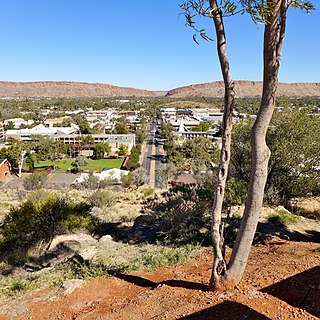
Alice Springs is a town in the Northern Territory, Australia; the third largest settlement after Darwin and Palmerston. The name Alice Springs was given by surveyor William Whitfield Mills after Alice, Lady Todd, wife of the telegraph pioneer Sir Charles Todd. Known colloquially as "The Alice" or simply "Alice", the town is situated roughly in Australia's geographic centre. It is nearly equidistant from Adelaide and Darwin.

Hermannsburg, also known as Ntaria, is an Aboriginal community in Ljirapinta Ward of the MacDonnell Shire in the Northern Territory of Australia, 125 kilometres (78 mi); west southwest of Alice Springs, on the Finke River, in the traditional lands of the Western Arrarnta people.

Aṉangu is the name used by members of several Aboriginal Australian groups, roughly approximate to the Western Desert cultural bloc, to describe themselves. The term, which embraces several distinct "tribes" or peoples, in particular the Ngaanyatjarra, Pitjantjatjara and Yankunytjatjara groups, is pronounced with the stress on the first syllable:.
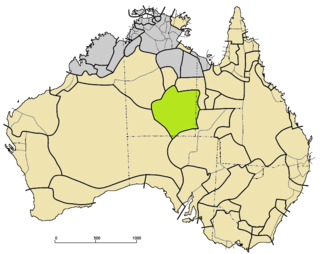
Arrernte or Aranda, or sometimes referred to as Upper Arrernte, is a dialect cluster in the Arandic language group spoken in parts of the Northern Territory, Australia, by the Arrernte people. Other spelling variations are Arunta or Arrarnta, and all of the dialects have multiple other names.

The Arrerntepeople, sometimes referred to as the Aranda, Arunta or Arrarnta, are a group of Aboriginal Australian peoples who live in the Arrernte lands, at Mparntwe and surrounding areas of the Central Australia region of the Northern Territory. Many still speak one of the various Arrernte dialects. Some Arrernte live in other areas far from their homeland, including the major Australian cities and overseas.
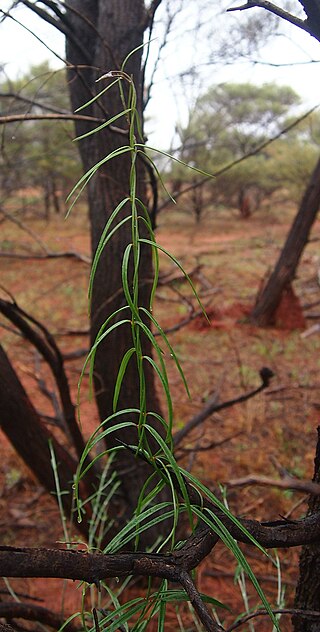
Leichhardtia australis, commonly known as the bush banana, silky pear or green vine is an Australian native plant. It is found in Central Australia and throughout Western Australia. It is a bush tucker food used by Indigenous Australians.
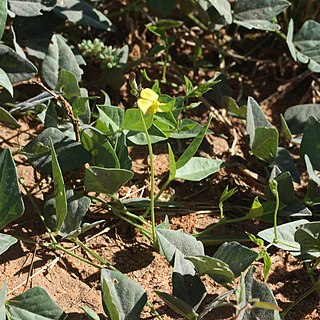
Vigna lanceolata, known as the pencil yam, native bean, Maloga bean, parsnip bean, Ngarlajiyi, small yam, yam, bush carrot, Wapurtali, Wapirti, and Wajaraki is an Australian native plant. Its name in the Arrernte language of Central Australia is Merne arlatyeye.
Indigenous Australian peoples traditionally classified food sources in a methodical way. Below are a few examples.

Cyperus bulbosus is a species of sedge found across Africa, the Middle East, Indian subcontinent, Southeast Asia, and Australia. In Australia, it is commonly called Nalgoo or (Australian) bush onion or "wild onion", but is not related to the onion or other Alliaceae. It is a component of Australian bushfood, but is considered an agricultural weed in other areas.

Haasts Bluff, also known as Ikuntji, is an Aboriginal Australian community in Central Australia, a region of the Northern Territory. The community is located in the MacDonnell Shire local government area, 227 kilometres (141 mi) west of Alice Springs. At the 2006 census, the community, including outstations, had a population of 207.

Bess Nungarrayi Price is an Aboriginal Australian activist and politician. She was a Country Liberal Party member of the Northern Territory Legislative Assembly from 2012 to 2016, representing the electorate of Stuart, and was Minister for Community Services in the Giles Ministry. She lives in Alice Springs in Central Australia, in the Northern Territory.
Wintjiya Napaltjarri, also known as Wintjia Napaltjarri No. 1, was a Pintupi-speaking Indigenous artist from Australia's Western Desert region. She is the sister of artist Tjunkiya Napaltjarri; both were wives of Toba Tjakamarra, with whom Wintjiya had five children.
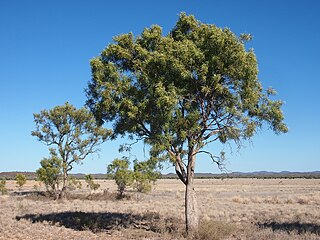
Atalaya hemiglauca, commonly known as whitewood or cattle bush, is a species of plant in the soapberry (Sapindaceae) family. It is native to northern and inland Australia where it occurs from Western Australia through the Northern Territory and South Australia to Queensland and northern New South Wales.

Peter Kenneth Latz is an agrostologist, botanist, ethnobotanist, and author from Central Australia. For 55 years he worked with the Eastern and Western Arrernte, Alyawarre, Anmatyerre, Pintupi/Luritja, Pitjantjatjara/Yankunytjatjara, and Warlpiri people to organise and share their cultural and scientific knowledge of central Australian plants. In many areas of Australia this knowledge has been lost, but it has been preserved in the Red Centre as a result of this lifelong collaboration. He has published articles and books on Australian plants, particularly on arid grasses and vegetation and Aboriginal plant use.
Margaret Heffernan, is a Central Arrernte linguist, author, interpreter and translator who is now a well respected elder in her community. Heffernan is responsible for developing the orthography of Arrernte.
William Hurle Liddle was a pastoralist who established Angas Downs Station, in Central Australia, taking up the first pastoral lease in 1929.
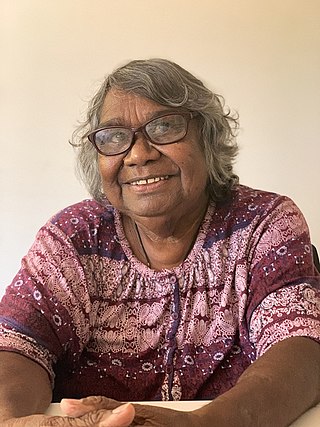
Kathleen Kemarre Wallace, was an Eastern Arrernte artist, author, custodian and cultural leader from Ltyentye Apurte in the Northern Territory of Australia.
Margaret Kemarre Turner, also known as M. K. Turner, was an Arrernte woman, who belonged to the Akarre people. Turner was an elder in her community, an interpreter, artist and author. She was also involved with the Institute for Aboriginal Development in Alice Springs where she taught language, culture and cross-cultural courses.
Little Flower Mission operated from 1938 to 1942 and it was a mission to Eastern Arrernte people who were living in and around the township of Alice Springs. The mission was established by Catholic missionaries, part of the Missionaries of the Sacred Heart order.
Therese Ryder is an Eastern Arrernte artist from Ltyentye Apurte Community, 82 km south east of Alice Springs. Ryder, part of the Iltja Ntjarra Many Hands Art Centre, is primarily a landscape artist and paints her traditional lands in the Central Desert. Ryder is also a linguist who significantly contributed to the Central and Eastern Arrernte Dictionary (1994) and also wrote a book, Ayeye thipe-akerte: Arrernte stories about birds (2017).